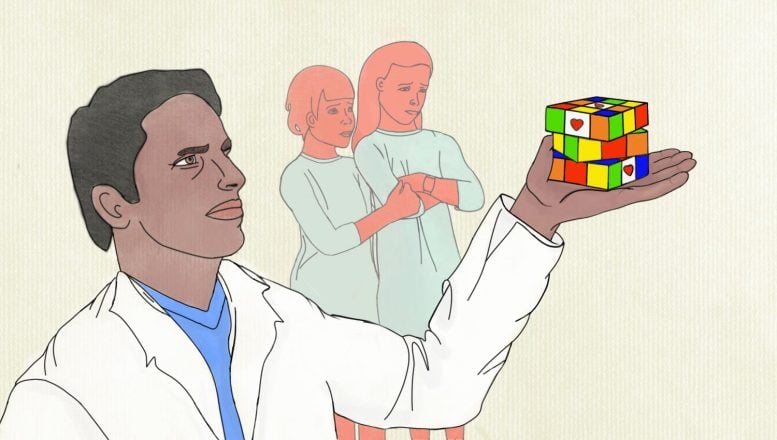
Stanford Medicine’s new study reveals inconsistencies in the U.S. pediatric heart transplant waitlist, suggesting that the sickest patients are not always prioritized.
A new study by Stanford Medicine highlights flaws in the U.S. pediatric heart transplant waitlist, showing that the current system fails to prioritize the sickest children.
The study suggests a shift towards a more nuanced approach, using a range of health indicators to assign risk scores and improve survival rates.
According to a new study led by Stanford Medicine experts, the method used across the United States to wait-list children for heart transplants does not consistently rank the sickest patients first.
The study will be published today (August 5) in the Journal of the American College of Cardiology.
Need for System Reform
Adding nuance to the wait-list system by accounting for more health factors could reduce children’s risk of dying while they await donor hearts, according to the study’s authors. A revision to the way donor hearts are assigned is already in process. The study adds evidence for why it is needed, they said.
“Wait-list mortality, which is the chance that a child will die while awaiting transplant, is higher in pediatric heart transplant than for virtually any other organ or age group,” said the study’s senior author, Christopher Almond, MD, professor of pediatrics. Almond cares for children before and after heart transplantation at Stanford Medicine Children’s Health.
“The current system is not doing a good job of capturing medical urgency, which is one of its explicit goals,” said the study’s co-lead author, economist Kurt Sweat, PhD, who conducted the research as a graduate student in economics at Stanford University. Sweat shares lead authorship of the study with Alyssa Power, MD, who was a postdoctoral scholar in pediatric heart failure/transplant at Stanford Medicine when she worked on the study.

The current method of listing children for heart transplant does not always rank the sickest kids first, a Stanford University-led study has found. Credit: Emily Moskal/Stanford Medicine
Historical Context and Current Challenges
In the last 25 years, the method used to rank infants and children on the waitlist for heart transplants has been revised three times; the most recent changes took effect in 2016. Over these decades, outcomes improved. Patients’ risk of dying on the waitlist fell from 21% to 13%, even while the total number of pediatric heart transplants increased.
But the decline in deaths is due to improvements in medical care rather than the changes in how organs are allocated, the study found.
“The goals of the current allocation system are to improve wait-list mortality and to allocate organs ethically and fairly,” Almond said. “Wait-list mortality has declined, which is a very good thing, but based on our analysis, it doesn’t look like the allocation changes made the difference. Although the intent behind the current system is to prioritize the children based on medical urgency, we saw that the system is not actually sequencing patients according to their risk.”
Statistical Insights and System Flaws
Infants and children who need heart transplants are added to a waiting list maintained by the United Network for Organ Sharing, the national nonprofit that manages all organ transplants across the country.
Pediatric donor hearts are in short supply, especially for infants and smaller children, as few children die in circumstances that allow their organs to be donated. Matching must account for several factors, including geographic locations of the donor and recipient, immune compatibility, and body size. The matching system is intended to prioritize sicker children for transplant and to function equitably.
The current waitlist relies on few factors to determine where a child ranks and uses only three categories of urgency: 1A, the most urgent status, followed by 1B and 2. Factors used to determine a child’s category include what type of heart problem they have (such as congenital heart disease, which is present at birth, or cardiomyopathy, a heart muscle problem that typically develops after birth) and the medications they are receiving.
The team analyzed data from all 12,408 infants and children less than 18 years of age who were listed for heart transplant between January 20, 1999, and June 26, 2023, in the United States. To see if the current wait-list system was functioning as intended, the researchers used statistical methods, borrowed from economics, that are typically used to study markets.
“From the perspective of economics, we think about this fundamentally as an allocation problem,” Sweat said. “We’ve got this scarce resource of donor hearts, and we want to make sure they’re going to candidates who can get the most usage from them. In the case of pediatric heart transplantation, with such high wait-list mortality, what that usually looks like is you want to prioritize patients who are sicker.”
The team compared how transplant candidates were actually ranked on the waitlist with how the candidates would have ranked if the listing order was based on medical urgency.
They also considered whether improvements in wait-list outcomes aligned chronologically with the allocation changes implemented in 2006 and 2016, which were intended to create a more equitable waitlist.
Wait-List Categories Don’t Work As Intended
One of the reasons the chance of dying on the waitlist dropped during the years studied is that children on the waitlist were also healthier in recent years: At the time of transplant, they were less likely to be supported with a ventilator, extracorporeal membrane oxygenation (which works like a heart-lung machine) or kidney dialysis, the study found.
However, the medical status of children within each of the three categories on the waitlist varied widely. In fact, the three categories showed significant overlap in the risk of mortality, the study found. In other words, some very sick children were categorized as priority 2 while others who were not as sick had a 1A status, meaning a less-sick child was sometimes offered a donor heart instead of a sicker child.
Also, the three wait-list categories are so broad that less-sick children were sometimes offered a heart before sicker children within the same category because they had been waiting longer, the study said.
Experts agree that a longer wait should not determine transplant priority, “because it can incentivize programs to list people early so you can build some wait time,” Almond said.
Surprisingly, wait-list rule changes in 2006 and 2016 were not linked to rapid improvements in mortality, as you would expect if the rule changes drove the improvements, the team found.
Rather, mortality decreased gradually from 1999 onward, driven by improvements to medical care, including advancements such as ventricular assist devices — mechanical pumps that support a child’s heart during the wait for transplant — and a better recognition of when to list a child for transplant. Over time, the gap in outcomes between patients of different races decreased, they found — a change that was linked to better outcomes overall.
During the study period, physicians also realized that, in infants whose immune systems are still immature, it is safe to transplant organs even when blood types don’t match. Gradual adoption of this practice helped reduce wait-list mortality in the youngest heart recipients, especially among babies with type O blood, who were previously the hardest to match, the study found.
Proposals for Future Allocation Improvements
The study’s findings suggest that the wait-list system should be revised to account for a broader range of medical factors than are currently considered — such as kidney function, liver function and whether a patient is malnourished — and should use the combination of factors to assign each child a numeric risk score to replace the current three categories, the authors said.
“The important thing is moving toward a continuous allocation score and refining it so you can account for the technological innovation that’s happening in patient care in the meantime,” Sweat said.
The revision should also account for whether a patient is healthy enough to benefit and recover from a transplant, Almond said. It would give the highest priority to children with the greatest need who have the best chance to recover from major surgery.
“It’s very challenging because if a patient is on full life support and their organs are shutting down, that person is very sick and may not survive the wait-list period. And if you transplanted them, those same risk factors mean they may not have a good outcome with transplant,” Almond said.
In September 2023, UNOS implemented a new lung transplant allocation system based on a continuous score, and the organization is drafting similar systems for other organs. It plans to have a proposal for how hearts should be allocated ready for review in 2025.
“It is really complicated to figure out how to do this well, but it appears there is still room for improvement,” Almond said.
Reference: 5 August 2024, Journal of the American College of Cardiology.
Researchers from Stanford Medicine’s Departments of Pediatrics and Cardiothoracic Surgery, the Stanford University Department of Economics, and the University of Texas Southwestern School of Medicine contributed to the research.
The research did not receive funding.









Be the first to comment on "When Heart Transplants for Kids Go Wrong: Stanford’s Startling Discovery"